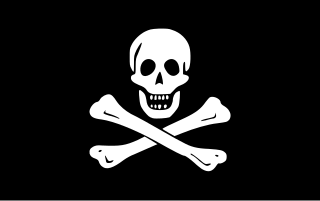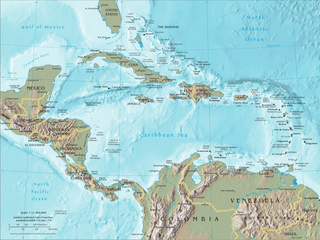Related Research Articles

Piracy is an act of robbery or criminal violence by ship or boat-borne attackers upon another ship or a coastal area, typically with the goal of stealing cargo and other valuable goods. Those who conduct acts of piracy are called pirates, while the dedicated ships that pirates use are called pirate ships. The earliest documented instances of piracy were in the 14th century BC, when the Sea Peoples, a group of ocean raiders, attacked the ships of the Aegean and Mediterranean civilizations. Narrow channels which funnel shipping into predictable routes have long created opportunities for piracy, as well as for privateering and commerce raiding. Historic examples include the waters of Gibraltar, the Strait of Malacca, Madagascar, the Gulf of Aden, and the English Channel, whose geographic structures facilitated pirate attacks. A land-based parallel is the ambushing of travelers by bandits and brigands in highways and mountain passes. Privateering uses similar methods to piracy, but the captain acts under orders of the state authorizing the capture of merchant ships belonging to an enemy nation, making it a legitimate form of war-like activity by non-state actors.

Buccaneers were a kind of privateers or free sailors peculiar to the Caribbean Sea during the 17th and 18th centuries. First established on northern Hispaniola as early as 1625, their heyday was from the Restoration in 1660 until about 1688, during a time when governments were not strong enough and did not consistently attempt to suppress them.

A privateer is a private person or ship that engages in maritime warfare under a commission of war. Since robbery under arms was a common aspect of seaborne trade, until the early 19th century all merchant ships carried arms. A sovereign or delegated authority issued commissions, also referred to as a letter of marque, during wartime. The commission empowered the holder to carry on all forms of hostility permissible at sea by the usages of war. This included attacking foreign vessels and taking them as prizes, and taking prize crews as prisoners for exchange. Captured ships were subject to condemnation and sale under prize law, with the proceeds divided by percentage between the privateer's sponsors, shipowners, captains and crew. A percentage share usually went to the issuer of the commission.

The era of piracy in the Caribbean began in the 1500s and phased out in the 1830s after the navies of the nations of Western Europe and North America with colonies in the Caribbean began combating pirates. The period during which pirates were most successful was from the 1660s to 1730s. Piracy flourished in the Caribbean because of the existence of pirate seaports such as Port Royal in Jamaica, Tortuga in Haiti, and Nassau in the Bahamas. Piracy in the Caribbean was part of a larger historical phenomenon of piracy, as it existed close to major trade and exploration routes in nearly all the five oceans.
William Wright was an English privateer in French service and later buccaneer who raided Spanish towns in the late 17th century.

The Golden Age of Piracy is a common designation for the period between the 1650s and the 1730s, when maritime piracy was a significant factor in the histories of the Caribbean, the United Kingdom, the Indian Ocean, North America, and West Africa.

Michel de Grammont was a French privateer. He was born in Paris, Kingdom of France and was lost at sea in the north-east Caribbean, April 1686. His privateer career lasted from around 1670 to 1686 during which he commanded the flagship Hardi. He primarily attacked Spanish holdings in Maracaibo, Gibraltar, Trujillo, La Guaira, Puerto Cabello, Cumana and Veracruz.

Bartholomew Sharp was an English buccaneer and privateer. His career of piracy lasted seven years (1675–1682). In the Caribbean he took several ships, and raided the Gulf of Honduras and Portobelo. He took command of an expedition into the Pacific and spent months raiding settlements on the Pacific Coast of South America including La Serena which he torched in 1680. His flagship, taken at Panama, was the Trinity.

Laurens Cornelis Boudewijn de Graaf was a Dutch pirate, mercenary, and naval officer in the service of the French colony of Saint-Domingue during the late 17th and early 18th century.
Captain John Coxon, sometimes referred to as John Coxen, was a late-seventeenth-century buccaneer who terrorized the Spanish Main. Coxon was one of the most famous of the Brethren of the Coast, a loose consortium of pirates and privateers. Coxon lived during the Buccaneering Age of Piracy.
Laurens Prins, anglicized as Lawrence Prince, was a 17th-century Dutch buccaneer, privateer and an officer under Captain Sir Henry Morgan. He and Major John Morris led one of the columns against Panama in 1671.

Pierre le Picard (1624–1690?) was a 17th-century French buccaneer. He was both an officer to l'Olonnais as well as Sir Henry Morgan, most notably taking part in his raids at Maracaibo and Panama, and may have been one of the first buccaneers to raid shipping on both the Caribbean and Pacific coasts.
Jean Fleury was a French naval officer and privateer. He is best known for the capture of two out of the three Spanish galleons carrying the Aztec treasure of Hernán Cortés from Mexico to Spain and one ship from Santo Domingo in 1522. This was one of the earliest recorded acts of piracy against the new Spanish Empire and encouraged the French Corsairs, Dutch Sea Beggars and English Sea Dogs to begin attacking shipping and settlements in the Spanish Main during the next several decades.
John Nutt was an English pirate. He was one of the more notorious brigands of his time raiding the coast of southern Canada and western England for over three years before his capture by Sir John Eliot in 1623. His arrest and conviction caused a scandal in the English court, after Nutt paid Eliot £500 in exchange for a pardon, and was eventually released by Secretary of State George Calvert.
Jan Willems, also known as Janke or Yankey Willems, was a 17th-century Dutch buccaneer. Based out of Petit-Goâve, Willems participated in a number of expeditions against the Spanish during the early to mid-1680s with other well-known privateers including Michiel Andrieszoon, Thomas Paine, Laurens de Graaf, Nicholas van Hoorn and Michel de Grammont.
Josiah Raynor (1665–1743) was a pirate active in the Red Sea. Before he was briefly a pirate captain, he was a sailor on the Batchelor’s Delight on which he sailed alongside William Dampier.
References
- ↑ Castillo, Dennis. The Maltese Cross: A Strategic History of Malta. Westport, Connecticut: Greenwood Publishing Group, 2006. (pg. 88) ISBN 0-313-32329-1
- ↑ Unger, Richard W. Dutch Shipbuilding Before 1800: Ships and Guilds. Assen: Van Gorcum, 1978. (pg. 110) ISBN 90-232-1520-6
- ↑ Earle, Peter. The Pirate Wars. New York: St. Martin's Press, 2005. (pg. 124) ISBN 0-312-33579-2
- ↑ Snelders, Stephen. The Devil's Anarchy: The Sea Robberies of the Most Famous Pirate Claes G. Compaen. New York: Autonomedia, 2005. (pg. 167) ISBN 1-57027-161-5
- ↑ Maclay, Edgar Stanton. A History of American Privateers. New York: D. Appleton & Co., 1899. (pg. 32)
- ↑ Abbott, Geoffrey. Execution: The Guillotine, the Pendulum, the Thousand Cuts, the Spanish Donkey, and 66 Other Ways of Putting Someone to Death. New York: St. Martin's Press, 2006. (pg. 155) ISBN 0-312-35222-0
- ↑ Haring, Clarence Henry. The Buccaneers in the West Indies in the XVII Century. Methuen, 1910. (pg. 125)
- ↑ Konstam, Angus. Scourge of the Seas: Buccaneers, Pirates and Privateers. Oxford: Osprey Publishing, 2007. (pg. 84) ISBN 1-84603-211-3
- ↑ Galvin, Peter R. Patterns of Pillage: A Geography of Caribbean-based Piracy in Spanish America, 1536-1718. New York: Peter Lang, 1999. (pg. 108) ISBN 0-8204-3771-9